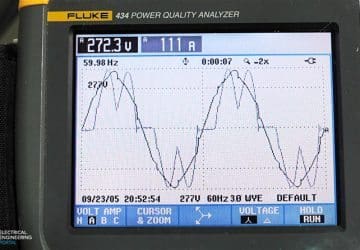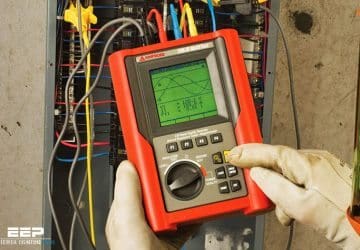4 steps to diagnose a potential harmonics related problem
If a plant engineer suspects that he might have a harmonics related problem, the following steps can easily be performed as an initial investigation into potential problems: Look for symptoms of harmonics as listed in Table 1 below. If one… Read more
Oct 05, 2016 | By Edvard Csanyi

How to locate harmonic currents and where to control them?
On radial utility distribution feeders and industrial plant power systems, the main tendency is for the harmonic currents to flow from the harmonic-producing load to the power system source. This is illustrated in Figure 1. The impedance of the power… Read more
Sep 16, 2016 | By Edvard Csanyi

5 anomalies in AC power that can damage your home devices
In addition to lightning, there are a number of other disturbances that can come in on the AC power lines and damage equipment. Some surge protectors can reduce or eliminate damage from some of these perturbations. There is considerable confusion… Read more
Apr 11, 2016 | By Edvard Csanyi

How to manage harmonic currents affecting the neutral
A number of measures can be taken to eliminate or reduce the effects of harmonic currents in the neutral conductor, in particular third harmonic currents. Let’s talk about the following five measures: modifications to the installation, star-delta transformer, transformer with… Read more
Mar 25, 2016 | By Edvard Csanyi

Reactive Power and Compensation Solution Basics For Students
The total power, the so-called apparent power, of a transmission network is composed of active and reactive power (Figure 1). While the power consumers connected into supply transform the active power into active energy, the reactive energy pertaining to the… Read more
Feb 17, 2016 | By Edvard Csanyi

Harmonics. What are they? What do they do?
The harmonics allow to represent any periodic waveform. In fact, according to Fourier’s theorem, any periodic function of a period T may be represented as a summation of: A sinusoid with the same period T; Some sinusoids with the same frequency… Read more
Jan 27, 2016 | By Edvard Csanyi

How to identify these four parameters and lower facility’s electricity bill
The world is more energy conscious these days. But unlike you, most of the world doesn’t pay electricity bill that rivals the cost of a four bedroom home. You understand the need to know where energy is being expended in… Read more
Jan 13, 2016 | By Edvard Csanyi

Smart Ways To Cut Down The Influence Of Harmonics
There are three possible ways of suppressing or at least reducing the influence of harmonics. The fourth way is a special case. Contents: Reducing generated harmonic currents Modifying the installation Filtering Special case – circuit breakers Generated harmonic currents can be reduced… Read more
Dec 28, 2015 | By Edvard Csanyi

Few things that capacitors do perfectly
Capacitors provide tremendous benefits to distribution system performance. Most noticeably, capacitors reduce losses, free up capacity, and reduce voltage drop. Let’s go a little bit into details. By canceling the reactive power to motors and other loads with low power… Read more
Oct 05, 2015 | By Edvard Csanyi

Acceptable levels of distortion in the mains supply system
In the mains supply system, harmonic voltage distortion is the consequence of the flow of harmonic currents through the impedances in the power supply circuit connected to the converter. A typical power supply system at an industrial or mining plant… Read more
Sep 26, 2015 | By Edvard Csanyi

What parallel redundancy does to the power distribution system?
Redundancy is a useful method of increasing reliability and optimising the balance between operation effectiveness and expenditure. In the context of reliability, redundancy signifies that a system will continue to function satisfactorily in spite of the failure of some of… Read more
Aug 07, 2015 | By Edvard Csanyi

Essential Basics of Total Harmonic Distortion (THD)
For a signal y, the total harmonic distortion (THD) is defined by the equation: This definition complies with that of standard IEC 61000-2-2. Note that the resulting value may exceed one. According to the standard, h can generally be limited to… Read more
Jul 22, 2015 | By Edvard Csanyi

What Is The Poor Power Quality?
Most electrical and electronic equipment is designed to operate from a power supply with a particular specification that usually defines the minimum and maximum limits for RMS (root mean-square) voltage and frequency. There is an expectation on the part of… Read more
Jun 05, 2015 | By Edvard Csanyi

5 Types of equipment which generates the most harmonics
Harmonic load currents are generated by all non-linear loads. This includes: Switched mode power supplies (SMPS) Electronic fluorescent lighting ballasts Variable speed drives (VSDs) Uninterruptible power supplies (UPS) Magnetic-cored devices The majority of modern electronic units use switched mode power… Read more
Apr 27, 2015 | By Edvard Csanyi

Detailed Overview of Power System Disturbances (Causes and Impacts)
To make the study of Power Quality problems useful, the various types of disturbances need to be classified by magnitude and duration. This is especially important for manufacturers and users of equipment that may be at risk. Manufacturers need to know what… Read more
Apr 17, 2015 | By Edvard Csanyi


